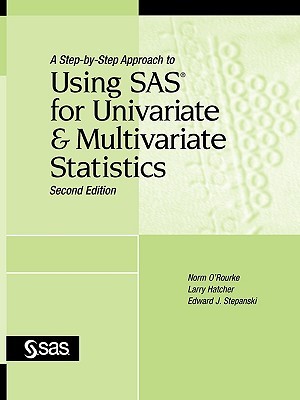
- We will send in 10–14 business days.
- Author: Norm O'Rourke
- Publisher: SAS Institute
- ISBN-10: 1590474171
- ISBN-13: 9781590474174
- Format: 21.6 x 27.6 x 2.6 cm, minkšti viršeliai
- Language: English
- SAVE -10% with code: EXTRA
A Step-By-Step Approach to Using SAS for Univariate and Multivariate Statistics, Second Edition (e-book) (used book) | bookbook.eu
Reviews
Description
Updated for SAS 9, A Step-by-Step Approach to Using SAS for Univariate and Multivariate Statistics, Second Edition, is an easy-to-understand introduction to SAS as well as to univariate and multivariate statistics. Clear explanations and simple language guide you through the research terminology, data input, data manipulation, and types of statistical analysis that are most commonly used in the social and behavioral sciences. Providing practice data inspired by actual studies, this book teaches you how to choose the right statistic, understand the assumptions underlying the procedure, prepare the SAS program for the analysis, interpret the output, and summarize the analysis and results according to the format prescribed in the Publication Manual of the American Psychological Association. Step by step, authors Norm O'Rourke, Larry Hatcher, and Edward Stepanski demonstrate how to perform the following types of analysis: simple descriptive statistics, measures of bivariate association, t tests for independent samples and paired samples, ANOVA and MANOVA, multiple regression, principal component analysis, and assessing scale reliability with coefficient alpha. This text is ideally suited to students who are beginning their study of data analysis, and to professors and researchers who want a handy reference on their bookshelf.
EXTRA 10 % discount with code: EXTRA
The promotion ends in 23d.14:23:31
The discount code is valid when purchasing from 10 €. Discounts do not stack.
- Author: Norm O'Rourke
- Publisher: SAS Institute
- ISBN-10: 1590474171
- ISBN-13: 9781590474174
- Format: 21.6 x 27.6 x 2.6 cm, minkšti viršeliai
- Language: English English
Updated for SAS 9, A Step-by-Step Approach to Using SAS for Univariate and Multivariate Statistics, Second Edition, is an easy-to-understand introduction to SAS as well as to univariate and multivariate statistics. Clear explanations and simple language guide you through the research terminology, data input, data manipulation, and types of statistical analysis that are most commonly used in the social and behavioral sciences. Providing practice data inspired by actual studies, this book teaches you how to choose the right statistic, understand the assumptions underlying the procedure, prepare the SAS program for the analysis, interpret the output, and summarize the analysis and results according to the format prescribed in the Publication Manual of the American Psychological Association. Step by step, authors Norm O'Rourke, Larry Hatcher, and Edward Stepanski demonstrate how to perform the following types of analysis: simple descriptive statistics, measures of bivariate association, t tests for independent samples and paired samples, ANOVA and MANOVA, multiple regression, principal component analysis, and assessing scale reliability with coefficient alpha. This text is ideally suited to students who are beginning their study of data analysis, and to professors and researchers who want a handy reference on their bookshelf.


Reviews